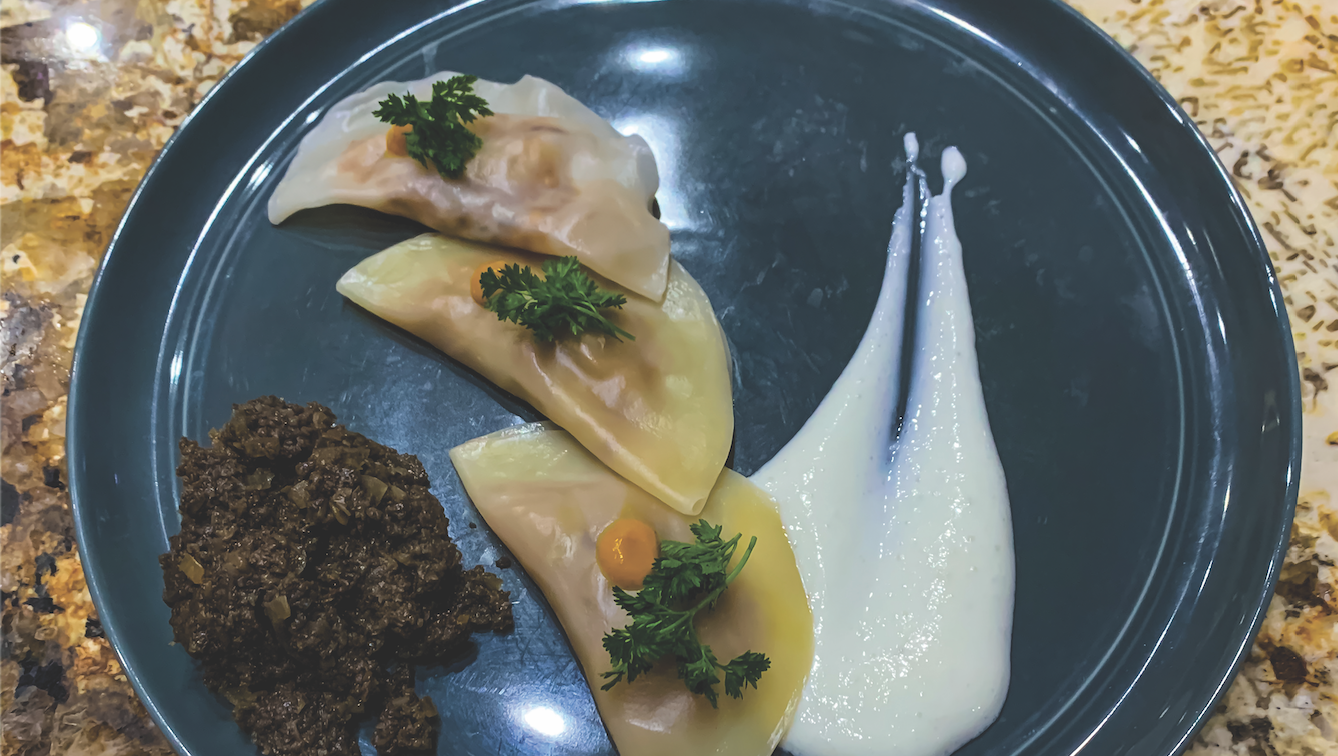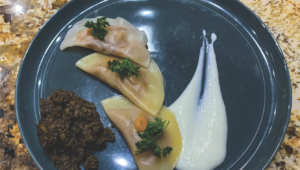Aushak is the national dish of Afghanistan. I first encountered the dish at the marvelous Afghani restaurants of Madison, Wisconsin restauranteur Ghafoor Zafari. His restaurants, the first of which featured an upscale Afghani cuisine, convinced me from the first taste that food of the Middle East could be more than falafels and shawarma (though there is nothing wrong with those).
There was something very appealing — at once exotic and familiar — about the delicate raviolis of sautéed leeks, the big and comfortable flavors of the meat sauce, and the fresh feeling of the yogurt sauce. As much as each of these elements pleased, Aushak is very much a case of the whole being greater than the sum of its parts. And it’s a whole that has as much of a place on a fine dining table as it does as street food.
Perhaps the secret to the appeal of Aushak is geographical and historical. As a major stop on the Silk Road — the ancient trade routes between Europe and China — Afghanistan necessarily reached its arms both east and west. Its culture and its food took something from both, never fully assimilating either. Aushak, like many Afghani dishes, shows that heritage — with the dumplings feeling like one-part Italian ravioli, one-part Chinese jiaozi.
But, like many Middle Eastern dishes, traditional Aushak combines yogurt (for creaminess) with meat (for richness and savory character). By substituting a rich mushroom duxelles for the ground beef of the original recipe, however, a fully kosher dairy-based dish results. While this version of Aushak is certainly different than the classic — lighter, more umami-forward — it is every bit as rich and tasty.
My version of the dish is, in addition to being kosher, closer in style and intent to that which Zafari might have served had he been Israeli rather than Afghani: unabashedly upscale and uncompromising.
Aushak with Duxelles
Serves 6
Ingredients
For the Duxelles
8 ounces white mushrooms
2 teaspoons butter
1 teaspoon canola oil
2 tablespoons finely minced shallot
1 tablespoon dry sherry
Kosher salt
1⁄2 teaspoon freshly grated nutmeg
For the Aushak:
2 leeks, white parts only, cleaned and finely chopped
1⁄3 teaspoon red chile flakes
1 tablespoon extra-virgin olive oil
Kosher salt
24 circular wonton wrappers (such as Gefen or Twin Marquis)
All-purpose flour
For the Chakah (Yogurt Sauce):
2 cups plain Greek yogurt
2 cloves garlic, minced
1 teaspoon salt
For the Garnish:
Fresh mint leaves
Amba Sauce (recipe below)
Directions
To Make the Duxelles:
- Roughly chop the mushrooms, place them in the bowl of a food processor, pulse a few times to break the mushrooms down, then process until finely minced.
- Transfer to a square of cheesecloth, wrap, and wring out the liquid. The result should be a nearly solid lump of chopped mushrooms.
- Melt the butter in the canola oil in a medium sauté́ pan over medium heat and heat until the foam subsides.
- Add the shallots and cook until they just turn translucent, about 1 minute.
- Add the mushrooms and cook, stirring often, until they begin to brown and there is almost no liquid remaining, 5 to 6 minutes.
- Stir in the sherry and cook until evaporated.
- Add the salt and nutmeg.
To Make the Aushak:
- In small sauté́ pan, cook the leeks with the chile flakes in the olive oil over medium heat until the leeks are translucent, about 2 minutes.
- Add the salt.
- Fill a small bowl with cold water, and starting with 1 wonton wrapper on a lightly floured surface, use your index finger to swipe a ring of water around the perimeter of the circular wonton wrapper.
- Spoon a teaspoon of the leeks into the center of the wrapper. Fold one side of the wonton wrapper over the filling to form a half moon, pressing down around the filling carefully to force out any air.
- Seal the edges of the Aushak by compressing them with your thumb and index finger.
- Repeat with the remaining wontons.
- As they are formed, transfer the Aushak to a plate, spread a little flour between the dumplings to keep them from sticking, and cover with a dry kitchen towel, turning them occasionally.
To Make the Chakah:
- Combine the yogurt, garlic, and salt in the bowl of a food processor and pulse to mix. Set aside
To Cook the Aushak and Serve:
- In a large pot, bring 8 cups of water to a boil and add the salt and oil.
- Carefully drop the Aushak in the water and cook until tender, about 3 minutes.
- Ladle a circle of the chakah onto each plate.
- Arrange three Aushak, straight sides in and circular facing outwards, around the chakah.
- Spoon two tablespoons of the duxelles over the chakah on the inside of the circle
- Garnish each Aushak with a mint leaf and some of the amba sauce.
Amba (Pickled Mango) Sauce
Makes about 1 1/2 cups
Ingredients
1 ripe mango and 1 unripe mango (about 1 1/2 pounds total)
2 large lemons
1 1/2 tablespoons extra-virgin olive oil
2 cloves garlic, minced
1/2 teaspoon yellow mustard seeds
1/2 teaspoon fenugreek seeds
1/2 teaspoon Aleppo pepper
1/2 teaspoon Spanish smoked paprika (aka pimenton)
1/2 teaspoon ground turmeric
1/2 teaspoon ground cumin
Directions
- Peel the mangos, cut the flesh of the fruit from the pit, and add it to the bowl of a food processor.
- Zest the lemons with a grater, reserving the fruit, and add the zest to the food processor.
- Pulse several times to combine, then increase the speed and process to purée, about 20 seconds.
- Heat the olive oil in a small sauté pan over medium heat. When hot, add the garlic, mustard seeds, fenugreek seeds, Aleppo pepper, smoked paprika, turmeric, and cumin and cook until the garlic is lightly golden, shaking the pan occasionally, about 2 to 3 minutes.
- Add the puréed mango to the pan and stir to combine. Taste and adjust the seasoning by adding salt or lemon juice, as desired.
- Let the sauce cool, then cover, transfer to the refrigerator, and store, for up to 1 week.











Comments